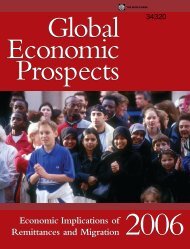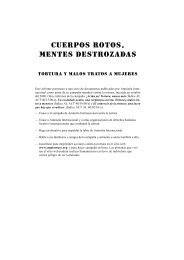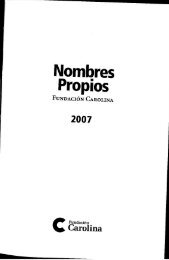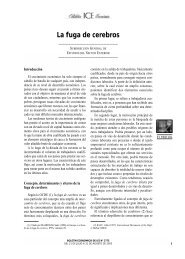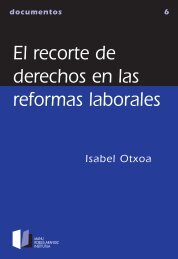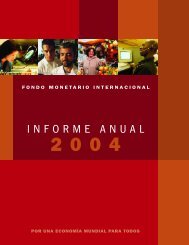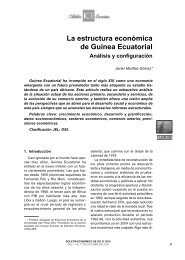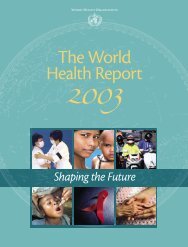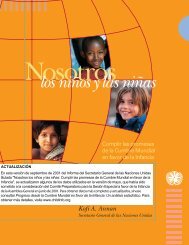Educación para todos: el imperativo de la calidad; Informe ... - eFaber
Educación para todos: el imperativo de la calidad; Informe ... - eFaber
Educación para todos: el imperativo de la calidad; Informe ... - eFaber
- No tags were found...
Create successful ePaper yourself
Turn your PDF publications into a flip-book with our unique Google optimized e-Paper software.
2.6: Distribución porcentual d<strong>el</strong> efecto estimado <strong>de</strong> los recursos c<strong>la</strong>ve en los resultados <strong>de</strong> los alumnos,sobre <strong>la</strong> base <strong>de</strong> 376 estimaciones <strong>de</strong> <strong>la</strong> función producción (Estados Unidos) . . . . . . . . . . . . . . . . . . . . . . . . . . . . . . . .. . . . . 732.7: Distribución porcentual d<strong>el</strong> efecto estimado <strong>de</strong> los recursos c<strong>la</strong>ve en los resultados <strong>de</strong> los alumnosen 96 estimaciones <strong>de</strong> <strong>la</strong> función producción (países en <strong>de</strong>sarrollo) . . . . . . . . . . . . . . . . . . . . . . . . . . . . . . . .. . . . . . . . . . . . . . . 742.8: Condiciones <strong>de</strong> una mejora <strong>de</strong> <strong>la</strong> eficacia <strong>de</strong> <strong>la</strong> escu<strong>el</strong>a: resultados <strong>de</strong> cinco estudios recapitu<strong>la</strong>tivos . . . . . . . . . . . . . 752.9: Com<strong>para</strong>ción <strong>de</strong> los mod<strong>el</strong>os <strong>de</strong> instrucción tradicionales y los constructivistas . . . . . . . . . . . . . . . . . . . . . . . . . . . . . . . .. . . 782.10: Condiciones más importantes <strong>para</strong> mejorar <strong>la</strong> eficacia <strong>de</strong> <strong>la</strong> enseñanza . . . . . . . . . . . . . . . . . . . . . . . . . . . . . . . .. . . . . . . . . . . 813.1: Tasas netas <strong>de</strong> frecuentación <strong>de</strong> los programas <strong>de</strong> AEPI entre los niños <strong>de</strong> 3 y 4 años,por sexo y número <strong>de</strong> horas <strong>de</strong> presencia (2000) . . . . . . . . . . . . . . . . . . . . . . . . . . . . . . . .. . . . . . . . . . . . . . . . . . . . . . . . . . . . . . . . . . 973.2: Distribución <strong>de</strong> los países por grupos en función d<strong>el</strong> niv<strong>el</strong> <strong>de</strong> su TNE y su TBEen <strong>la</strong> enseñanza primaria (2001) . . . . . . . . . . . . . . . . . . . . . . . . . . . . . . . .. . . . . . . . . . . . . . . . . . . . . . . . . . . . . . . . . . . . . . . . . . . . . . . . . . . . 1033.3: Número <strong>de</strong> niños sin esco<strong>la</strong>rizar, por región (1998 y 2001) . . . . . . . . . . . . . . . . . . . . . . . . . . . . . . . .. . . . . . . . . . . . . . . . . . . . . . . . . . 1083.4: Número previsible <strong>de</strong> años <strong>de</strong> esco<strong>la</strong>rización, por región (2001 y evolución <strong>de</strong>s<strong>de</strong> 1990) . . . . . . . . . . . . . . . . . . . . . . . . . . . 1193.5: Niv<strong>el</strong>es <strong>de</strong> calificación y formación <strong>de</strong> los docentes <strong>de</strong> primaria en catorce países <strong>de</strong> bajos ingresos (1995) . . . . . . 1233.6: Distribución <strong>de</strong> los países en función <strong>de</strong> <strong>la</strong> proporción alumnos/docente en <strong>la</strong> enseñanza primaria (2001) . . . . . . . . 1283.7: Alfabetización <strong>de</strong> los adultos (15 años y más) por sexo y región (2000-2004) . . . . . . . . . . . . . . . . . . . . . . . . . . . . . . . .. . . . . . 1453.8: Tasas <strong>de</strong> alfabetización <strong>de</strong> adultos en cinco países muy pob<strong>la</strong>dos, por sexo (1990-1994 y 2000-2004) . . . . . . . . . . . . . 1473.9: Alfabetización <strong>de</strong> los jóvenes (15-24 años), por sexo y región (2000-2004) . . . . . . . . . . . . . . . . . . . . . . . . . . . . . . . .. . . . . . . . . 1483.10: Distribución <strong>de</strong> los países en función <strong>de</strong> <strong>la</strong> distancia que les se<strong>para</strong>, por término medio,<strong>de</strong> <strong>la</strong> consecución <strong>de</strong> los objetivos <strong>de</strong> <strong>la</strong> EPT (2000) . . . . . . . . . . . . . . . . . . . . . . . . . . . . . . . .. . . . . . . . . . . . . . . . . . . . . . . . . . . . . . . 1543.11: Distribución <strong>de</strong> los países en función <strong>de</strong> <strong>la</strong> evolución entre 1998 y 2001 <strong>de</strong> <strong>la</strong> distancia que les se<strong>para</strong>,por término medio, <strong>de</strong> <strong>la</strong> consecución <strong>de</strong> los objetivos <strong>de</strong> <strong>la</strong> EPT (2000) . . . . . . . . . . . . . . . . . . . . . . . . . . . . . . . .. . . . . . . . . . . 1564.1: Opciones <strong>de</strong> <strong>la</strong>s políticas <strong>de</strong> educación en <strong>la</strong> <strong>de</strong>terminación <strong>de</strong> los objetivos <strong>de</strong> los p<strong>la</strong>nesnacionales <strong>de</strong> estudio, tal como figuran en <strong>la</strong> Convención sobre los Derechos <strong>de</strong> Niño . . . . . . . . . . . . . . . . . . . . . . . . . . . . 1654.2: Ten<strong>de</strong>ncias <strong>de</strong> los objetivos <strong>de</strong>c<strong>la</strong>rados <strong>de</strong> los p<strong>la</strong>nes <strong>de</strong> estudios <strong>de</strong>s<strong>de</strong> los años 1980 a los años 2000 . . . . . . . . . . . 1664.3: Promedio porcentual d<strong>el</strong> tiempo total <strong>de</strong> instrucción asignado a <strong>la</strong>s matemáticas en <strong>la</strong> enseñanza primariay <strong>el</strong> primer ciclo <strong>de</strong> <strong>la</strong> secundaria, por grado y por periodo (Situaciones com<strong>para</strong>bles por grado) . . . . . . . . . . . . . . . . . 1674.4: Promedio porcentual <strong>de</strong> países que han hecho obligatoria <strong>la</strong> enseñanza <strong>de</strong> “nuevas” disciplinasen <strong>la</strong> enseñanza primaria y <strong>el</strong> primer ciclo <strong>de</strong> <strong>la</strong> secundaria, por grado y por periodo . . . . . . . . . . . . . . . . . . . . . . . . . . . . . 1684.5: Promedio mundial d<strong>el</strong> tiempo anual <strong>de</strong> instrucción, por grado y periodo . . . . . . . . . . . . . . . . . . . . . . . . . . . . . . . .. . . . . . . . . . . 1704.6: Promedio d<strong>el</strong> tiempo anual <strong>de</strong> instrucción, por región y grado en 2000 . . . . . . . . . . . . . . . . . . . . . . . . . . . . . . . .. . . . . . . . . . . . 1704.7: Lenguas utilizadas en <strong>la</strong> educación en China y Asia Sudoriental . . . . . . . . . . . . . . . . . . . . . . . . . . . . . . . .. . . . . . . . . . . . . . . . . . . 1744.8: Evaluación sumativa y evaluación formativa . . . . . . . . . . . . . . . . . . . . . . . . . . . . . . . .. . . . . . . . . . . . . . . . . . . . . . . . . . . . . . . . . . . . . . . 1774.9: Mod<strong>el</strong>os principales <strong>de</strong> formación inicial <strong>de</strong> los docentes . . . . . . . . . . . . . . . . . . . . . . . . . . . . . . . .. . . . . . . . . . . . . . . . . . . . . . . . . . 1814.10: Su<strong>el</strong>do medio <strong>de</strong> los maestros <strong>de</strong> primaria en proporción d<strong>el</strong> PIB por habitante, por región (1975-2000)(Países con un PIB inferior à 2.000 dó<strong>la</strong>res en 1993) . . . . . . . . . . . . . . . . . . . . . . . . . . . . . . . .. . . . . . . . . . . . . . . . . . . . . . . . . . . . . . . . 1834.11: Mejora <strong>de</strong> <strong>la</strong> escu<strong>el</strong>a: repercusiones en <strong>la</strong> política <strong>de</strong> educación . . . . . . . . . . . . . . . . . . . . . . . . . . . . . . . .. . . . . . . . . . . . . . . . . . . 1904.12: Marco <strong>para</strong> una escu<strong>el</strong>a amiga d<strong>el</strong> niño . . . . . . . . . . . . . . . . . . . . . . . . . . . . . . . .. . . . . . . . . . . . . . . . . . . . . . . . . . . . . . . . . . . . . . . . . . . . 1924.13: Prácticas <strong>de</strong> corrupción más importantes en <strong>el</strong> sector <strong>de</strong> <strong>la</strong> educación . . . . . . . . . . . . . . . . . . . . . . . . . . . . . . . .. . . . . . . . . . . . 2065.1: Compromisos <strong>de</strong> ayuda bi<strong>la</strong>teral total y a <strong>la</strong> educación, promedios bienales (2001-2002) . . . . . . . . . . . . . . . . . . . . . . . . . . 2115.2: Compromisos <strong>de</strong> ayuda bi<strong>la</strong>teral a <strong>la</strong> educación y <strong>la</strong> educación básica, promedios bienales (2001-2002) . . . . . . . . . . . 2145.3: Priorida<strong>de</strong>s <strong>de</strong> <strong>la</strong> ayuda bi<strong>la</strong>teral a <strong>la</strong> educación y <strong>la</strong> educación básica (2001-2002) . . . . . . . . . . . . . . . . . . . . . . . . . . . . . . . 2155.4: Composición <strong>de</strong> <strong>la</strong> ayuda bi<strong>la</strong>teral a <strong>la</strong> educación, promedios bienales en porcentaje (2001-2002) . . . . . . . . . . . . . . . . . 2165.5: Compromisos anuales <strong>de</strong> ayuda multi<strong>la</strong>teral por término medio (exceptuados los d<strong>el</strong> Banco Mundial),promedios bienales (1990-2000 y 2001-2002) . . . . . . . . . . . . . . . . . . . . . . . . . . . . . . . .. . . . . . . . . . . . . . . . . . . . . . . . . . . . . . . . . . . . . . . 2165.6: Compromisos bi<strong>la</strong>terales y multi<strong>la</strong>terales en favor <strong>de</strong> <strong>la</strong> educación (promedios bienales, 1999-2000 y2001-2002) (en miles <strong>de</strong> millones <strong>de</strong> dó<strong>la</strong>res constantes <strong>de</strong> 2001) . . . . . . . . . . . . . . . . . . . . . . . . . . . . . . . .. . . . . . . . . . . . . . . . . . 2185.7: Número <strong>de</strong> países beneficiarios <strong>de</strong> <strong>la</strong> ayuda bi<strong>la</strong>teral (2001-2002) . . . . . . . . . . . . . . . . . . . . . . . . . . . . . . . .. . . . . . . . . . . . . . . . . . 2225.8: Índice <strong>de</strong> Proliferación <strong>de</strong> los Donantes (IPD) en <strong>la</strong> ayuda a <strong>la</strong> educación . . . . . . . . . . . . . . . . . . . . . . . . . . . . . . . .. . . . . . . . . . 2235.9: Documentos <strong>de</strong> estrategia <strong>de</strong> lucha contra <strong>la</strong> pobreza (DELP) y p<strong>la</strong>nes <strong>de</strong> educación, por región <strong>de</strong> <strong>la</strong> EPT . . . . . . . . 230





